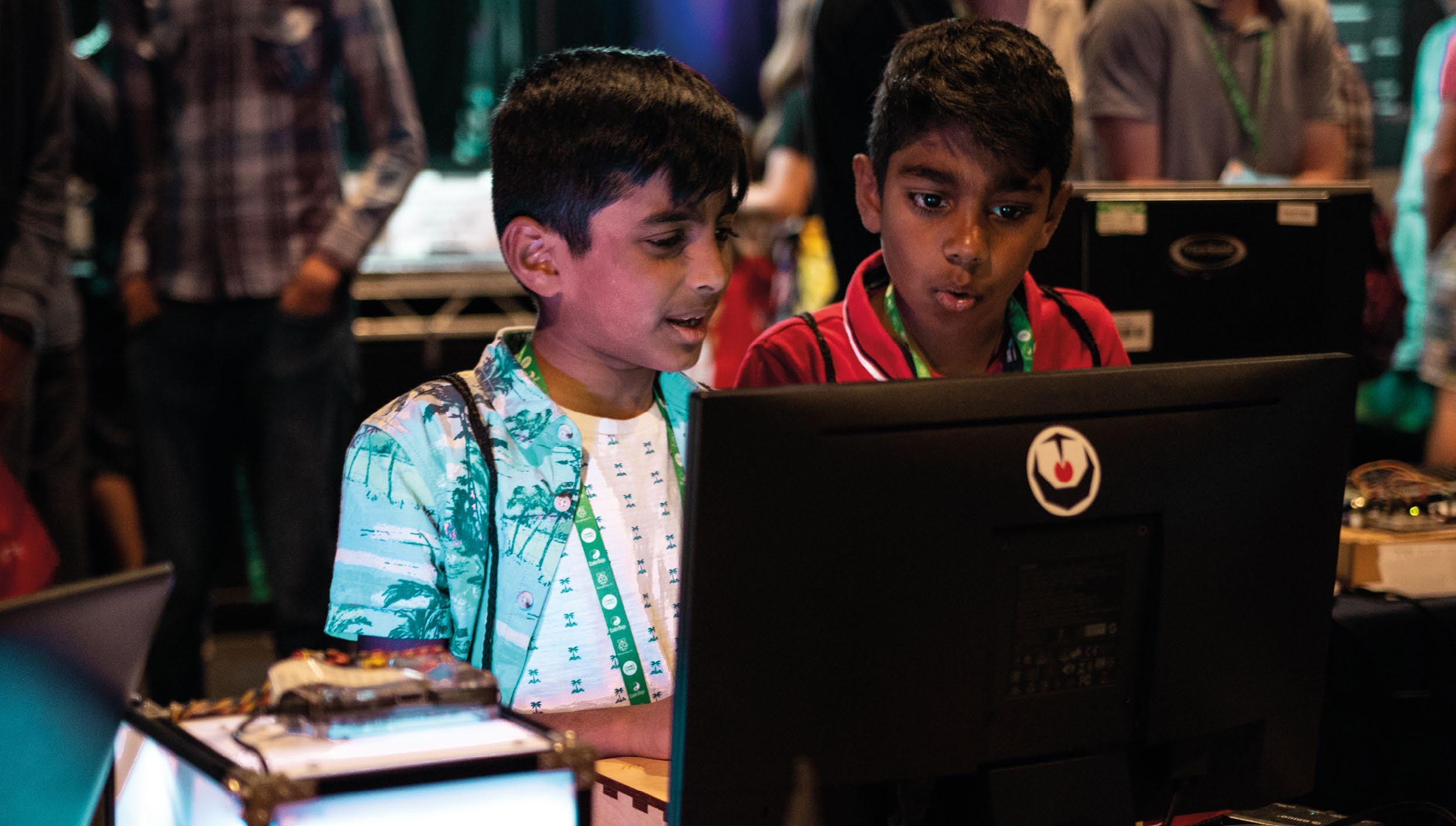
6 minute read
PEER INSTRUCTION
Using peer instruction in lessons helps students learn, retain, and discuss computing concepts
Peer instruction (PI) is an instructional technique first proposed in the 1990s by Eric Mazur,1 whose research demonstrated the benefits of focused discussion for pupils’ understanding and retention in physics. Subsequent studies have highlighted similar benefits of using PI in teaching
Advertisement
SUMMARY
Peer instruction (PI) can replace a traditional teaching approach by combining preinstruction, multiple-choice questions (MCQs), and peer discussion, to encourage deeper engagement with the content in question.
Benefits
■ It is a straightforward approach for educators to apply in their classrooms ■ It leads to roughly double the learning gains when compared with no PI ■ Learners value the PI approach, especially the discussion element ■ Learners are more likely to retain key concepts and knowledge taught using PI ■ Peer-led discussion promotes learning
Considerations
■ PI should follow some pre-instruction stimulus, ideally before the lesson ■ Make sure that learners understand the rationale and benefits of PI ■ Always encourage participation over accuracy; PI is a tool for learning, not assessment ■ Give learners challenging questions and enough time to discuss them ■ Decide whether you want to collect response data, and if so, how other subjects, including computing.2, 3 Here, we explore PI and its benefits, look at constructing a good multiple-choice question (MCQ), and give some advice on bringing PI to your classroom.
What is peer instruction?
PI is a teaching approach that combines pre-instruction, MCQs, and peer discussion. Pre-instruction includes reading, videos, and so on, which learners can use to study and become familiar with the material in question before the class. The educator will carefully construct MCQs based on the pre-instruction material. In class, those MCQs are combined with peer discussion to explore and challenge student understanding.
PI is carried out as follows:
1. Learners complete a pre-instruction task (ideally outside class) to help them become familiar with the relevant concepts and knowledge. 2. The teacher poses a carefully selected
MCQ. Learners have limited time to individually vote for their answer, using a method such as voting cards, clickers, or raising their hands. 3. Learners then discuss the question and their answers in small groups, aiming for a consensus. 4. The teacher displays the same question, and now, learners vote according to their group consensus. 5. Optionally, the teacher shares the results of both votes to highlight where responses have changed. 6. Finally, the teacher leads a class discussion about the question, sharing the correct answer and exploring the incorrect answer options (distractors).
MOST PUPILS RECOMMEND PI TO THEIR OTHER TEACHERS
Benefits
While most studies examining PI have so far focused on its use in higher education, the practice offers many benefits which should transfer to other settings:
■ Mazur1 demonstrated that PI leads to significant learning gains for learners: those engaged with PI made up to twice as much progress as other learners. Similar effects have been found in subsequent studies,2 which also highlight the importance of the discussion element of PI. ■ The same studies indicate that using
PI in teaching helps students to retain knowledge. ■ Once PI is part of the regular teaching practice, most students value the approach, recognise its benefits, value the discussion, and would recommend
PI to their other teachers.2

■ The peer instruction process
■ PI is fairly straightforward to implement, and evidence shows that even teachers who are new to the practice can quickly see its positive effects.2 ■ Some researchers cite anecdotal evidence that PI may encourage learners to develop a growth mindset.4
What makes a good MCQ?
Carefully constructed MCQs are a key aspect of PI. Good-quality MCQs are harder to write than you would think, as teachers have to predict the misconceptions their learners are likely to hold. For some topic areas, there are lists of known misconceptions; for others, teachers need to rely on their experience. While there are no definitive rules for developing MCQs, these are some guidelines:5
■ Questions should be clear and unambiguous ■ Each question should test only one concept ■ Learners should be able to answer questions quickly ■ Teachers should learn something from each incorrect response ■ It shouldn’t be possible to answer correctly while still holding on to a misconception
The image on page 56 shows an example of an MCQ. Can you identify the correct response and explain what might lead learners to select the incorrect responses?
Considerations for applying PI
■ For many teachers and learners, classroom PI represents a change in practice. It is important to be clear about the purpose of this approach and how it can benefit learners. ■ PI isn’t an assessment tool, but a means of instruction. Educators should shift the focus away from getting the correct answers, and instead, promote the participation and discussion aspects of the technique. ■ A PI activity should be given as much time as possible. This is especially important for the discussion step, which should last at least two to four minutes.1
This can feel like a long time, but it is time well spent. ■ If using an online voting system — such as handheld clickers or web-based quizzes — the recorded data can be helpful in predicting which learners may require extra interventions. ■ Questions should be challenging enough to promote discussion. Mazur suggests that the best results are seen where 50 percent of learners get the initial question wrong.1 ■ Pre-instruction is important. With older learners, a flipped approach is best, in which students are introduced to the learning material before the class. They prepare by reading, watching a video, or similar. Where home learning is not possible, PI activities should build on previous lessons, or even on content studied earlier in the lesson.
REFERENCES
1 Crouch, C. H., & Mazur, E. (2001). Peer instruction: Ten years of experience and results. American Journal of Physics, 69(9), 970–977. helloworld.cc/peer1 2 Porter, L. et al. (2016). A Multi-institutional Study of Peer Instruction in Introductory Computing. In: Proceedings of the 47th ACM Technical Symposium on Computing Science Education. New York, ACM. 358–363. helloworld.cc/peer2 3 Simon, B., & Cutts, Q. I. (2012). Peer instruction: a teaching method to foster deep understanding. Communications of the ACM, 55(2), 27–29.
helloworld.cc/peer3
4 Simon, B., Hundhausen, C., McDowell, C., Werner, L., Hu, H., & Kussmaul, C. (2019). Students As Teachers and Communicators. In: Fincher, S. & Robins, A. (eds.) The Cambridge Handbook of Computing Education Research. Cambridge Handbooks in Psychology. Cambridge, Cambridge University Press, 827–858. helloworld.cc/peer4 5 Barton, C. (2017, November 29). What makes a good diagnostic question? Medium. Available from: helloworld.cc/peer5. helloworld.cc/peer5
Where to start
If you’d like to try PI in your classroom, consider the following tips:
■ Review your content and highlight opportunities for pre-instruction.
Consider what learning can be moved outside the classroom to allow for discussion time during the lesson. ■ Review and trial some existing MCQs (helloworld.cc/computingMCQs) using
PI to diagnose some of your learners’ misconceptions. ■ Write your own MCQs, describe the misconception that each answer addresses, and share the questions with other educators. ■ Encourage learners to deepen their understanding of a topic by writing their own MCQs. ■ Visit peerinstruction4cs.com for more guidance and resources.










